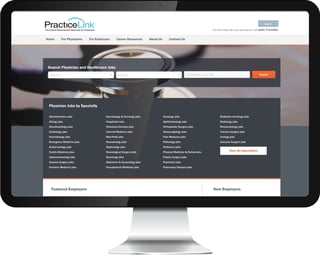
Donna Ecclestone, FASPR, director of physician integration and onboarding for Duke University Medical Center, recently joined us on a PracticeLink inTraining Physician Recruitment Webinar to share how physician recruiters and onboarders play an important role in overall retention. Here’s a glimpse of what webinar attendees learned.

Donna Ecclestone, FASPR, director of physician integration/onboarding, Duke University Medical Center
The physician you’ve been courting signed the contract!
Congratulations. It’s tempting to close the proverbial book—to check the position off your to-do list and turn your attentions to your other physician needs. But don’t do so too quickly. You still have an important role to play in the physician’s onboarding process, which, in turn, strongly influences that physician’s experience in your organization and willingness to stay longterm.
Onboarding includes familiarizing a physician with your organization’s mission, policies, protocol, culture and more. Its goal is to integrate new hires into both the organization and the community. A study by Aberdeen Group found that having a standard onboarding process results not only in higher productivity and engagement among new hires but also in 50 percent higher retention rates. This means that proper onboarding can actually decrease your turnover—reducing the number of positions you’ll have to fill in the future and freeing you from the cycle of filling the same positions over and over again.
Proper and proactive onboarding starts with knowing why physicians choose to leave practices and tackling these issues from the get-go. Most physicians who desire to leave a practice do so for the same few reasons: unmet expectations, poor cultural fit, poor communication with management, minimal input into decision-making and lack of appreciation or recognition. Each of these reasons can be mitigated during the recruitment and onboarding process if considered up front.
Onboarding issue 1: unmet expectations
As a recruiter, you are a physician’s first point of contact within the organization. It is up to you not only to provide an accurate job description, but also to discover a candidate’s preferences and goals and determine whether they align with the reality of your organization. If they do align and you move forward with hiring the candidate, it becomes your responsibility to communicate their needs and expectations to all parties involved in the onboarding process. This includes those who handle logistical items like credentialing, licensing and protocol training, and it also includes organization members who will play a role in welcoming the physician to the community, like managers and mentors. The goal is to prevent the rude awakening of a reality that doesn’t line up with expectations.
Onboarding issue 2: poor cultural fit
Help your new hire feel plugged in right away by lining up a first-day lunch for them or hosting a welcome event to connect them with colleagues. But also remember that, when it comes to fit, it’s important to onboard not only the physician but also their family. Make a point of providing a hospital tour to the whole family, and try to connect them with other physician families and spousal groups. It’s also a good idea to schedule periodic check-ins with the physician to learn how they and their family are settling in.
Onboarding issue 3: poor communication with management
Don’t stop at connecting your new hire with colleagues, though; it’s also important to connect them with management early on. When your physician starts, send an introduction memo to management, set up a meet and greet with leadership, and encourage higher-ups to check in with them regularly to ensure they’re feeling included and heard.
Onboarding issue 4: minimal input into decision-making
Physicians who are more engaged with an organization are more likely to stay long-term, which means that it’s in your organization’s best interest to develop new hires’ leadership responsibilities early on. In addition to encouraging this among managers, discuss decision-making processes with physicians during the onboarding process. As you inform your new hires of organizational policy, make sure you also discuss how they can have a say in it. Share more than just the organization’s mission, vision and values; share how physicians can have input.
Onboarding issue 5: lack of appreciation or recognition
Set the tone of appreciation within the organization by scheduling little acts of recognition on your calendar. Order a welcome basket to greet the physician’s family when they move to town. Have a white coat pressed and ready for your new hire’s first day. But don’t stop after the first week. Schedule a one-month lunch check-in for you, the physician and their spouse, and leadership, and make a habit of sending birthday and anniversary cards to new and established physicians alike. Little acts of appreciation go a long way.
Final tips
Overall, when it comes to onboarding, remember what it’s like to be new and treat your new hires accordingly. The organizational dynamics and lingo that seem so familiar to you are all new to your physician. Take the time to go over everything from workplace policies to building layout to continuing education funding. And, as much as it is within your power to influence the organization, make physician engagement a priority—by setting up mentor programs, making stay interviews a regular part of proceedings, hosting physician lounge lunches or facilitating team-building events. This will positively influence not only your new hires but also your current physicians, improving morale and encouraging providers to stay with your organization for the long haul.
Welcoming new hires
Make your new hires feel at home by making these simple tactics part of your onboarding process:- Send a welcome basket to greet your physician’s family when they move to town.
- Have a white coat pressed and ready for their first day.
- Line up a first-day lunch for them.
- Host a welcome event to connect your new hire with colleagues.
- Set up a meet and greet to introduce your hire to leadership.
- Schedule a hospital tour for the whole family.
- Connect the physician’s family with other physician families.
- Schedule a one-month check-in for you, the physician and their spouse, and leadership.
- Put their birthday and work anniversary on your calendar so you can send regular cards.









